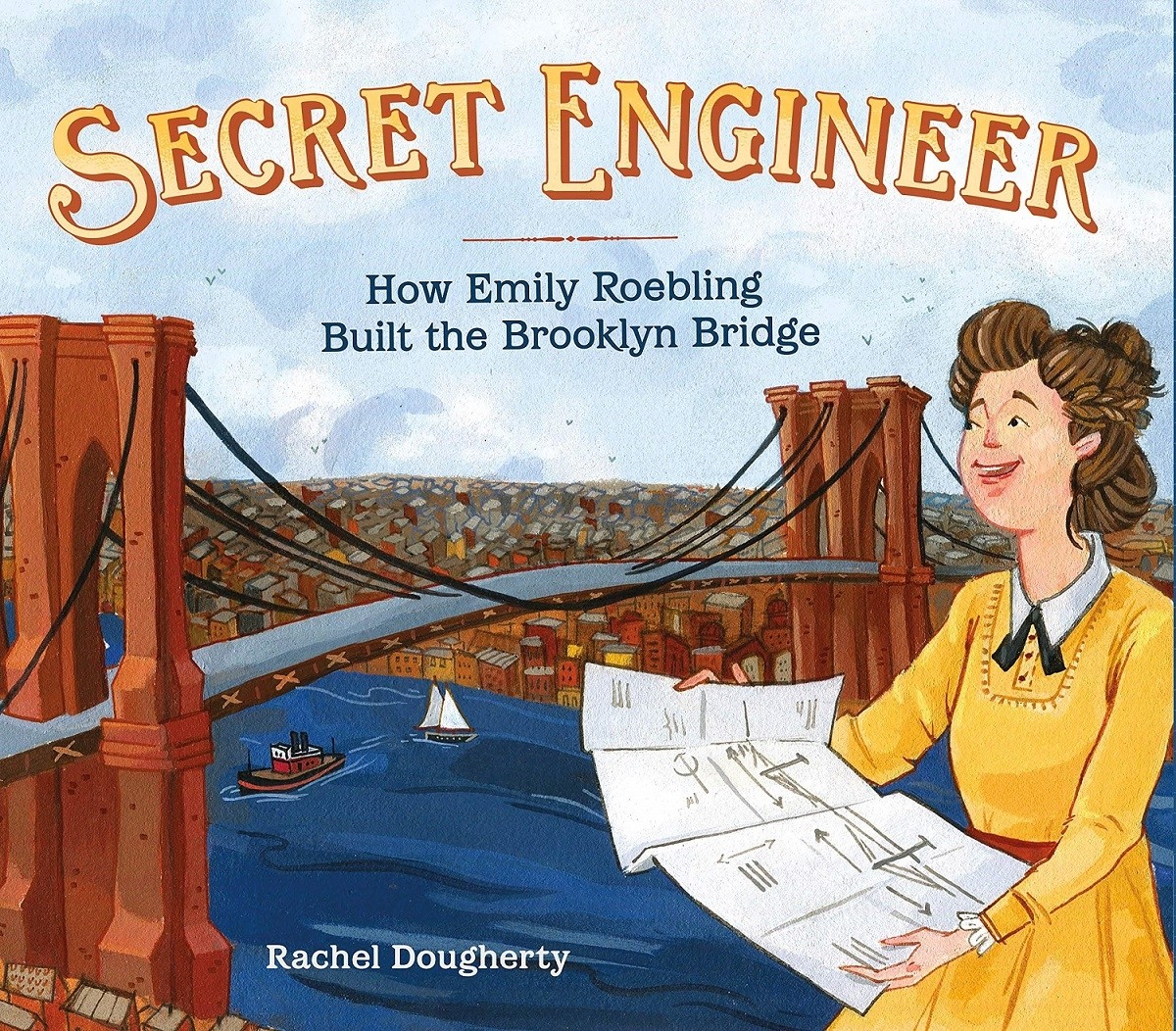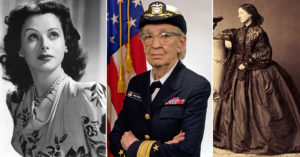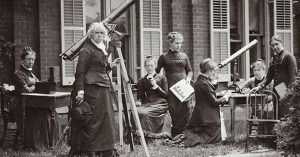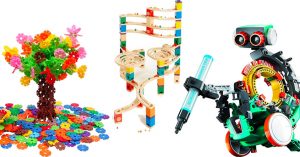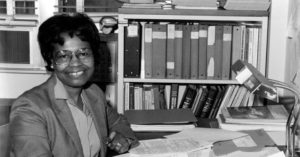Emily Warren Roebling became the first female field engineer in history as the "surrogate chief engineer" of one of the greatest architectural projects of the 19th century, the construction of the Brooklyn Bridge.
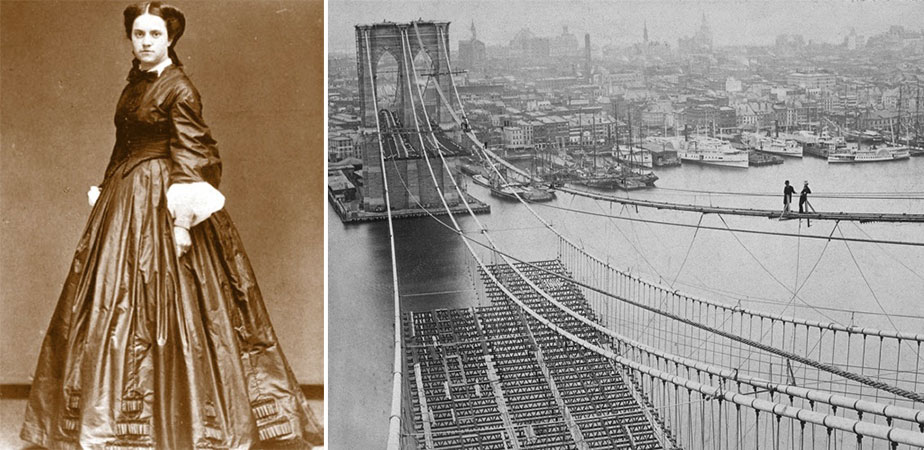 When the Brooklyn Bridge was completed after fourteen years of construction in 1883, Emily Warren Roebling — the "woman who saved the Brooklyn Bridge" — was the first to cross it by carriage, carrying a live rooster in her lap as a sign of victory. Early in its construction, Roebling's husband, Washington, the chief engineer in charge of the bridge’s construction, became severely debilitated and bedridden due to decompression sickness. Emily Roebling stepped in and, for over a decade, oversaw the completion of one of the greatest architectural feats of the 19th century — making history by becoming the first female field engineer in the process. "I don’t think that the Brooklyn Bridge would be standing were it not for her," asserts Erica Wagner, the author a biography about Washington Roebling. "She was absolutely integral."
When the Brooklyn Bridge was completed after fourteen years of construction in 1883, Emily Warren Roebling — the "woman who saved the Brooklyn Bridge" — was the first to cross it by carriage, carrying a live rooster in her lap as a sign of victory. Early in its construction, Roebling's husband, Washington, the chief engineer in charge of the bridge’s construction, became severely debilitated and bedridden due to decompression sickness. Emily Roebling stepped in and, for over a decade, oversaw the completion of one of the greatest architectural feats of the 19th century — making history by becoming the first female field engineer in the process. "I don’t think that the Brooklyn Bridge would be standing were it not for her," asserts Erica Wagner, the author a biography about Washington Roebling. "She was absolutely integral."
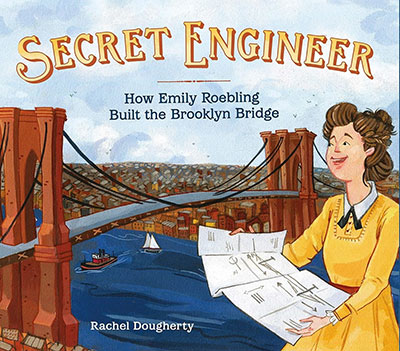 Emily Warren was born in Cold Spring, New York on September 23, 1843. As a teenager, she attended the Georgetown Academy of the Visitation in Washington, DC, where she studied history, astronomy, and algebra, among other subjects, in addition to needlework and housekeeping. In 1864, she met her future husband, Washington, who was serving as an engineering officer on the staff of her brother, General G.K. Warren, during the Civil War. Washington was the son of John Roebling, an eminent German-American civil engineer who was in the process of designing what he called "the greatest bridge in existence" — the future Brooklyn Bridge. The couple were married in 1865, and the newlyweds soon left for Europe to study caissons, the watertight structures filled with compressed air that would allow workers to dig under the East River and plant the bridge's footings.
Emily Warren was born in Cold Spring, New York on September 23, 1843. As a teenager, she attended the Georgetown Academy of the Visitation in Washington, DC, where she studied history, astronomy, and algebra, among other subjects, in addition to needlework and housekeeping. In 1864, she met her future husband, Washington, who was serving as an engineering officer on the staff of her brother, General G.K. Warren, during the Civil War. Washington was the son of John Roebling, an eminent German-American civil engineer who was in the process of designing what he called "the greatest bridge in existence" — the future Brooklyn Bridge. The couple were married in 1865, and the newlyweds soon left for Europe to study caissons, the watertight structures filled with compressed air that would allow workers to dig under the East River and plant the bridge's footings.
They returned to America in 1868, just before John Roebling died from tetanus following an accident at the bridge's construction site. Washington immediately took over as chief engineer, while Emily stayed home to tend the couple's young child. But it wasn't long before Washington also succumbed to the dangers of the construction effort. His frequent entry and exit of the pressurized caissons, led to a case of “caisson’s disease” or decompression sickness, a little-understood condition at the time that frequently led to crippling injury and even death. Over the course of the bridge's construction, over one hundred workers were killed or left severely impaired by decompression sickness, including Washington who became partially paralyzed, blind, deaf and mute.
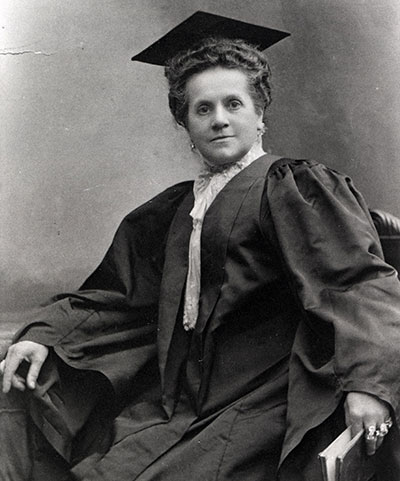 Emily Warren Roebling after receiving her law certificate in 1899.
Emily Warren Roebling after receiving her law certificate in 1899.At first, Emily primarily relayed information from Washington to his assistants but over time, as historian Marilyn Weigold, who wrote a biography about Emily Roebling entitled Silent Builder, she became the "surrogate chief engineer." As the New York Times reported at the time, “Mrs. Roebling applied herself to the study of engineering, and she succeeded so well that in a short time she was able to assume the duties of chief engineer." For over a decade, she dealt with contractors, supervised staff, inspected construction, and handled politicians and reporters — and, by the time the bridge was completed, she had become the public face of one of the most significant construction projects of the era.
It took fourteen years to complete the bridge, and when it was done, Roebling was hailed for overseeing construction of an architecture masterpiece. During the bridge's opening ceremonies, U.S. Congressman Abram Stevens Hewitt saluted her in a speech: "The name of Emily Warren Roebling will... be inseparably associated with all that is admirable in human nature and all that is wonderful in the constructive world of art," he proclaimed, saying the Brooklyn Bridge would be "an everlasting monument to the sacrificing devotion of a woman and of her capacity for that higher education from which she has been too long disbarred."
After the Brooklyn Bridge was completed, Emily Roebling devoted herself to many women's and humanitarian causes, and wrote an award-winning essay, A Wife's Disabilities, criticizing the many laws that discriminated against women. She traveled widely, and she also fulfilled her dream of pursuing further education, receiving a law certificate from New York University in 1899. In the years following the Brooklyn Bridge's construction, her contributions were largely forgotten, with most historians focusing on the accomplishments of her husband or father-in-law.
In recent years, however, her role as de facto chief engineer has received more recognition, and, based on a letter to her son that she wrote in 1898, Roebling herself never doubted how essential she was to its success: "I have more brains, common sense and know-how generally than have any two engineers, civil or uncivil, and but for me the Brooklyn Bridge would never have had the name Roebling in any way connected with it!" While few remember her name today, a plaque still stands on the Brooklyn Bridge, dedicating it to the memory of her father-in-law, her husband — and Emily Roebling herself.
Books About Emily Warren Roebling and Women in Engineering
Secret Engineer: How Emily Roebling Built the Brooklyn Bridge
Secret Engineer: How Emily Roebling Built the Brooklyn Bridge
As a girl, Emily Roebling was an eager learner — but girls didn't need to know math and science, and certainly not engineering. As an adult, her husband had an ambitious plan for a bridge that would "link Manhattan and Brooklyn," and when construction began, Roebling insisted on learning more about it. And when her husband fell ill, she stepped in, supervising every aspect of the project, and ensuring that the Brooklyn Bridge, one of New York's most iconic landmarks, was finished. This picture book biography celebrates the secret engineer who refused to give up on an architectural wonder.
How Emily Saved the Bridge: The Story of Emily Warren Roebling and the Building of the Brooklyn Bridge
How Emily Saved the Bridge: The Story of Emily Warren Roebling and the Building of the Brooklyn Bridge
Women couldn't be engineers when Emily Roebling was young, but she was well-educated and had a love for math and science. Her whole family was honored when her husband, Washington Roebling, was named chief engineer for the Brooklyn Bridge, a massive and ambitious project. But when he fell sick with "caisson disease" — what we now understand as decompression sickness — Emily was determined to step in. She carried messages from her husband, learned everything she could, and took over monitoring the construction. People hailed her for saving the bridge, and when it opened, she was the first person to cross! With informative text, imagined dialogue in speech bubbles, and bold, colorful collage illustrations, this is a compelling tribute to a STEM pioneer.
Gutsy Girls Go For Science: Engineers
Gutsy Girls Go For Science: Engineers
Engineering touches almost everything we do, whether it's opening a carton of milk for breakfast or crossing a bridge that connects a city! In this book from the Gutsy Girls Go For Science series, kids will learn about five women in engineering: Ellen Swallow Richards, Emily Warren Roebling, Kate Gleason, Lillian Moller Gilbreth, and Mary Jackson. They'll also test out some hands-on STEM projects, from conducting a virtual tour of a model bridge to researching organizational psychology. With a fun narrative style and full-color pages, this book is sure to inspire future engineers.
Girls Who Build: Inspiring Curiosity and Confidence to Make Anything Possible
Girls Who Build: Inspiring Curiosity and Confidence to Make Anything Possible
Carpenter Katie Hughes was often the only woman on a construction site, and she knew that teaching girls to use tools would help. Her non-profit, Girls Build, invites girls ages 8 to 14 to develop confidence and construction skills — and now her first book encourages girls everywhere to do the same! Inside you'll find photos of 45 builder girls, each accompanied by information about her favorite build, her top tips for new builders, and more. Then, check out the how-to guide full of techniques and safety tips for common tools, and use your new skills to create thirteen do-it-yourself projects from picture frames to playhouses. This empowering guide is sure to help a new generation of girls discover they can build anything!
Women Of Steel And Stone
22 Inspirational Engineers, Architects, and Landscape Designers
Women Of Steel And Stone
22 Inspirational Engineers, Architects, and Landscape Designers
Inspire her dreams of creation with this book featuring biographies of 22 groundbreaking architects, engineers, and landscape designers! Each capsule biography describes that woman's strengths and passions as a child, as well as the challenges they faced as they established themselves in their careers. Intriguing sidebars explore related topics, as well as the landmark events that affected each figure, including the industrial revolution, the women's suffrage movement, and the civil rights movement. This entry in the Women of Action series will fascinate budding engineers!
Girls Garage
How to Use Any Tool, Tackle Any Project, and Build the World You Want to See
Girls Garage
How to Use Any Tool, Tackle Any Project, and Build the World You Want to See
When girls get building, big things happen! Emily Pilloton founded the nonprofit Girls Garage in 2013, using her background in architecture and construction to help girls get confident with tools as they build real-world projects to help their community. Now, in this book, she provides the same guidance to girls everywhere! This book includes all the information a would-be builder needs, including 175 illustrated tool guides, 21 essential skills, and 11 how-to projects she can try herself. Plus, this 300-page compendium includes encouraging stories from real-life girls and women builders. Part how-to manual, part inspirational guide, this book will give girls confidence that there's nothing they can't plan, fix, or build!

Today, the Brooklyn Bridge is an iconic piece of American architecture — but there was every chance that the project would fail. In the late 1800s when the bridge was designed and constructed, a bridge of its size was unprecedented, and many wondered if it were even possible. Then, disaster struck both the original designer, John Roebling, and his son Washington. Accidents and tragedies were common for the construction workers, too. But thanks to the unwavering leadership of Emily Warren Roebling, Washington's wife and a gifted engineer in her own right, the Brooklyn Bridge rose tall into this sky. This inspiring story of vision and hope pays tribute to all those who made the bridge a reality.
The Engineer's Wife: A Novel
The Engineer's Wife: A Novel
Emily Roebling is an unconventional woman, with plans to fight for women's suffrage and dreams of making her mark in history. Then, her husband begs her for help. Washington Roebling is the Chief Engineer of the Brooklyn Bridge, but when he's injured on the job, he needs Emily to step in and take his place to ensure the project is completed. Emily fights all the obstacles of an enormous engineering project, as well as resistance due to her gender, but as she pushes the project forward, she wonders if anyone will remember her contributions. This stunning novel, based on the true story of the construction of the Brooklyn Bridge, is an emotional look at a woman who realizes the legacy she's building may not be her own.
The History of Women in Engineering and Math Poster
The History of Women in Engineering and Math Poster
Celebrate women in STEM with his poster featuring pioneering female engineers and mathematicians! This laminated, 23 by 35 inch poster features Hypatia of Alexandria, Maria Gaetana Agnesi, Sophie Germain, Ada Lovelace, Martha J. Coston, Emily Warren Roebling, Sofia Kovalevskaya, Kate Gleason, Mary Walton, Lillian Moller Gilbreth, Emmy Noether, Edith Clarke, Olive Wetzel Dennis, M. Gertrude Rand, Elsie Eaves, Irmgard Flügge-Lotz, Katherine Johnson, Beatrice Hicks, Yvonne C. Brill, Marilyn Jorgensen Reece, Ursula Burns, and Helen Greiner.
Structural Engineering: Bridges and Skyscrapers
Structural Engineering: Bridges and Skyscrapers
Get ready to explore structural engineering with this kit from Thames and Kosmos! As kids build twenty different models with the modular building pieces, they'll learn key principles like tension, compression, shear, and bending. The projects teach kids about trusses, columns, arches, and more ways that structural engineers build our cities to be strong and safe. It’s a fascinating way for budding architects and engineers to learn the science behind the structures we use every day.
Engino Structures: Buildings and Bridges
Engino Structures: Buildings and Bridges
With Engino Structures: Buildings and Bridges set, you can learn all about buildings and how they literally support our lives! Construct different types of bridges and find out how their architecture design provides massive weight support. Discover all the types of forces applied and how engineers manage to reduce their effects. With 9 working models to build, including five different types of bridges, budding engineers will love this set.









